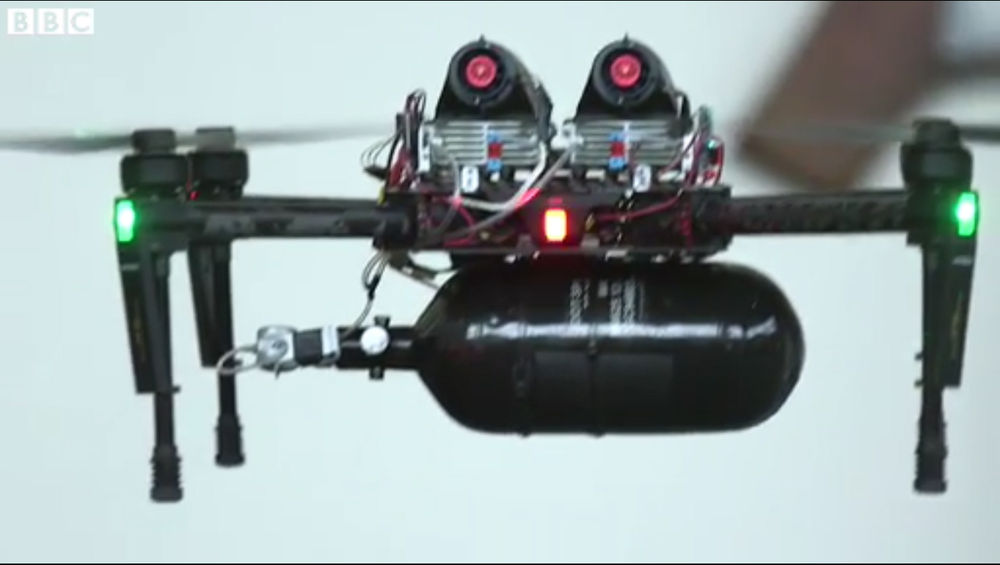Environment & Energy
Related: About this forumDown with the batteries, I’m flying “fuel cell”!
Elektormagazine.com | April 12, 2016
With hydrogen fuel cells, a commercial, electric drone could spend up to two hours hanging in the sky, be refueled almost instantly after landing, and then take another 120 minutes in the air. Such performance beats batteries hands down.

Intelligent Energy attached a hydrogen fuel cell to a DJI Matrice 100 quadcopter. The fuel cell and its fuel weigh just 3.5 pounds, which is lighter than the battery it replaces. Hydrogen fuel sometimes comes with unique risks, but the National Hydrogen Association thinks those risks are overblown.
The company has been making hydrogen fuel cells since 2001, and recently demonstrated their drone on BBC’s Click. Intelligent Energy isn’t the first to make such a device: Boeing and others have their own fuel-cell drones. What makes this design stand out is the simple reality of it: a normal quadcopter, with a new power source, hovering in a gymnasium as though it was supposed to do this all along...snip
MORE: https://www.elektormagazine.com/news/down-with-the-batteries-i-m-flying-fuel-cell
Watch a hydrogen powered drone fly BBC News-Click UK
Mar 25, 2016
Jen Copestake has been given exclusive access to the test flights of a drone powered by a hydrogen fuel cell. Intelligent Energy's fuel cell can power a modified drone for up to two hours - about six times longer than the average with a normal battery.
Refuelling with compressed hydrogen takes a few minutes compared to recharging a battery.
The company sees its drones being primarily used in industry for agriculture and oil and gas mapping, before being offered as a consumer product.
Intelligent Energy
http://www.intelligent-energy.com/
Drones know- H2 is #1

OKIsItJustMe
(19,938 posts)[font size=3]The Ion Tiger program demonstrates a practical, lightweight fuel cell system for unmanned airvehicles (UAVs) to significantly improve battlefield surveillance and communications capabilities.
Ion Tiger’s electric fuel cell propulsion system has the low noise and low signature of a battery-powered UAV, while taking advantage of hydrogen, a high-energy fuel. The 550-W (0.75-horsepower) fuel cell has about four times the efficiency of a comparable internal combustion engine. The Ion Tiger flew for 26 hours in November 2009 while carrying a 5-pound payload using hydrogen compressed to 5000-psi in a carbon/aluminum pressure vessel. In May 2013, the same researchers at the U.S. Naval Research Laboratory flew their fuel cell powered Ion Tiger UAV for 48-hours and 1 minute on April 16-18 by using liquid hydrogen fuel in a new, NRL-developed, cryogenic fuel storage tank and delivery system. These 1-day and 2-day demonstrations prove that hydrogen fuel cells provides a clear path to long endurance electric flight: in comparison, the Ion Tiger would be able to fly for only 4 hours on the comparable amount of lithium batteries.
The Naval Research Laboratory's research on fuel cell systems and UAVs converge successfully in the Ion Tiger to enable long-endurance missions, allowing a large cruise range and reducing the number of daily launches and landings. The electric power system has the additional features of instant starting, near-silent operation, and low thermal signature. Fuel cell technologies can deliver energy savings and increased capabilities across the operational spectrum, to ground, air, and undersea vehicles and for man-portable power generation.
Principal Investigator:
K. Swider-Lyons
Chemistry Division
Naval Research Laboratory
Washington DC 20375
Publication Approval:
13-1231-3360
[font size=4]Key publications[/font]
K. E. Swider-Lyons, Stroman, R. O. , Rodgers, J. A. , Edwards, D. , MacKrell, J. A. , Schuette, M. W. , and Page, G. S. , “Liquid hydrogen fuel system for small unmanned air vehicles”, in Proceedings of 51st AIAA Aerospace Sciences Meeting including the New Horizons Forum and Aerospace Exposition 2013, Grapevine, TX, 2013. BibTex
K. E. Swider-Lyons, MacKrell, J. A. , Rodgers, J. A. , Page, G. S. , Schuette, M. W. , and Stroman, R. O. , “Hydrogen Fuel Cell Propulsion for Long Endurance Small UAVs”, in Proceedings of the Naval Centennial of Flight Forum, 2011. BibTex [/font][/font]
http://www.naval-technology.com/projects/ion-tiger-uav/
…

…
[/font]
And check out what Boeing is doing: